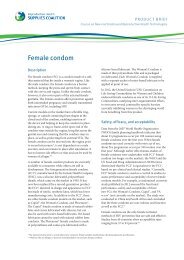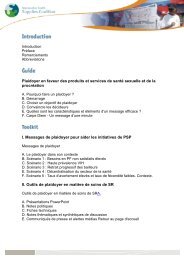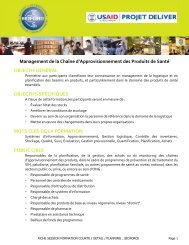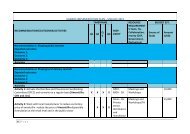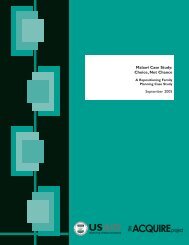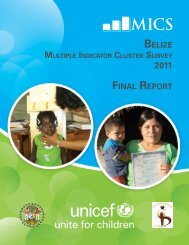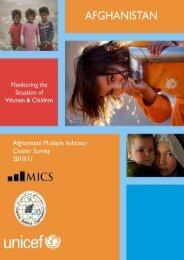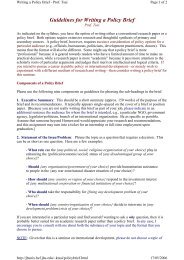Frequently Asked Questions on the Prequalification of Medicines for ...
Frequently Asked Questions on the Prequalification of Medicines for ...
Frequently Asked Questions on the Prequalification of Medicines for ...
Create successful ePaper yourself
Turn your PDF publications into a flip-book with our unique Google optimized e-Paper software.
The design and requirements <strong>for</strong><br />
bioequivalence studies are to be<br />
found in WHO TRS 937 14 and in<br />
<strong>the</strong> European <strong>Medicines</strong> Agency’s<br />
(EMA) “Guidance <strong>on</strong> <strong>the</strong> investigati<strong>on</strong><br />
<strong>of</strong> bioequivalence” 15<br />
The comp<strong>on</strong>ents <strong>of</strong> a comm<strong>on</strong><br />
protocol <strong>for</strong> a specific reproductive<br />
health product type<br />
have been agreed up<strong>on</strong>. For<br />
combined oral c<strong>on</strong>traceptive<br />
tablets, progestogen-<strong>on</strong>ly and<br />
emergency c<strong>on</strong>traceptive pills,<br />
a randomized, single-dose, twoperiod,<br />
two-treatment, cross-over<br />
bioequivalence study is required.<br />
However, <strong>the</strong> injectable<br />
c<strong>on</strong>traceptive, depot medoxyprogester<strong>on</strong>e<br />
acetate (DMPA), is<br />
administered every 90 days ei<strong>the</strong>r<br />
as a deep intramuscular or subcutaneous<br />
injecti<strong>on</strong>. The durati<strong>on</strong> <strong>of</strong><br />
acti<strong>on</strong> <strong>of</strong> <strong>the</strong> drug may be l<strong>on</strong>ger<br />
than 90 days and measurable<br />
levels <strong>of</strong> MPA may be found in <strong>the</strong><br />
blood up to 140 days. There<strong>for</strong>e, it<br />
is recommended that a study with<br />
a randomized, single dose, parallel<br />
design should be undertaken <strong>for</strong><br />
this product.<br />
One <strong>of</strong> <strong>the</strong> major issues relates to<br />
<strong>the</strong> number <strong>of</strong> subjects. Annex 7<br />
<strong>of</strong> TRS 937 and <strong>the</strong> EMA guidance<br />
both state <strong>the</strong> required parameters<br />
<strong>for</strong> determining bioequivalence<br />
and that “The number <strong>of</strong> evaluable<br />
subjects in a bioequivalence<br />
study should not be less than 12”.<br />
However, it is necessary to obtain an<br />
adequate sample size calculati<strong>on</strong><br />
from a pr<strong>of</strong>essi<strong>on</strong>al statistician in<br />
order to determine <strong>the</strong> number <strong>of</strong><br />
subjects that should be included in<br />
a study.<br />
The parameters to be analysed from<br />
<strong>the</strong> study data are <strong>the</strong> area under<br />
<strong>the</strong> curve (AUC (0-t)<br />
and AUC (0-∞)<br />
) and<br />
<strong>the</strong> maximum plasma/serum c<strong>on</strong>centrati<strong>on</strong><br />
(C ). It is also useful<br />
max<br />
to measure time to maximum<br />
plasma/serum c<strong>on</strong>centrati<strong>on</strong> (t ) max<br />
and terminal phase half-life time (t ) ½<br />
but statistical evaluati<strong>on</strong> <strong>of</strong> <strong>the</strong>se<br />
two parameters is not required.<br />
For <strong>the</strong> test product to be in <strong>the</strong> acceptance<br />
limit <strong>for</strong> bioequivalence<br />
with <strong>the</strong> innovator, <strong>the</strong> 90% c<strong>on</strong>fidence<br />
interval <strong>of</strong> <strong>the</strong> mean ratio <strong>of</strong><br />
C and <strong>of</strong> AUC <strong>of</strong> <strong>the</strong> two products<br />
max<br />
must be within 80.00% to 125.00%.<br />
Knowledge <strong>of</strong> <strong>the</strong> expected with-in<br />
subject (<strong>for</strong> crossover studies) or between-subject<br />
(<strong>for</strong> parallel studies)<br />
variability <strong>for</strong> <strong>the</strong>se parameters <strong>for</strong><br />
<strong>the</strong> particular drug will allow a statistician<br />
to calculate <strong>the</strong> sample size<br />
required <strong>for</strong> a study to have <strong>the</strong><br />
power to meet <strong>the</strong>se criteria.<br />
14 WHO Expert Committee <strong>on</strong> Specificati<strong>on</strong>s <strong>for</strong> Pharmaceutical Preparati<strong>on</strong>s, 40th<br />
report, Technical Report Series 937, 2006. Annex 7. Multisource (generic) pharmaceutical<br />
products: guidelines <strong>on</strong> registrati<strong>on</strong> requirements to establish interchangeability.<br />
Annex 9. Additi<strong>on</strong>al guidance <strong>for</strong> organizati<strong>on</strong>s per<strong>for</strong>ming in vivo bioequivalence<br />
studies.<br />
15 European <strong>Medicines</strong> Agency, 2010. Guidance <strong>on</strong> <strong>the</strong> investigati<strong>on</strong> <strong>of</strong> bioequivalence.<br />
Doc ref: CPMP/EWP/QWP/1401/98Rev1/Corr.<br />
13



